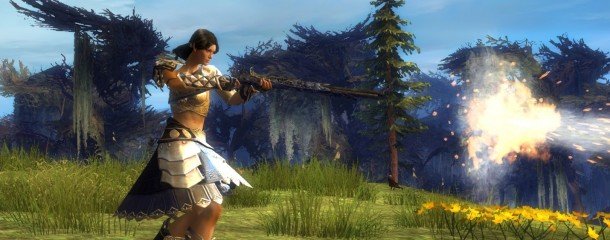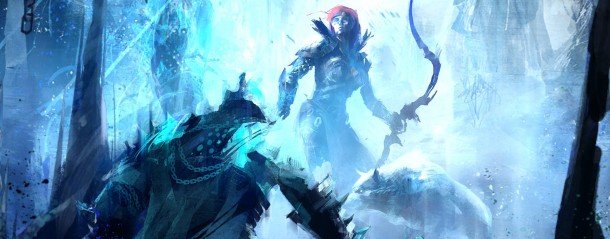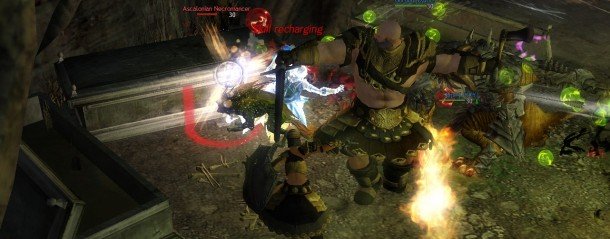Guild Wars 2 review as it happens

Hour 42:
My thoughts on Guild Wars 2 have shifted about as I've approached and exceeded level 30. Not in a negative way, far from it, but hitting 30 seems to be a watershed moment. It's the point that you're officially introduced to Lion's Arch, the pirate city that acts as a hub for the rest of the game. It's when you choose the faction that will determine the next 50 levels of your personal story. It's when you gain access to your final skill slot and the elite abilities that occupy it. It's when - after more than 30 hours with the game - it finally delivers its first proper instance, and its first real PvE challenge.
For all of these reasons I've been determined to get a single character to thirty as fast as possible - which is why I've not been rolling alts over the course of this review. That's the next step. The last dozen hours on my warrior have been about getting to thirty and then attempting to take a full measure of the game.
I spend levels 26 to 30 in Gendarran Fields, the third human area and the final part of the trade route between Divinity's Reach and Lion's Arch. As such, it mixes the themes and conflicts of the previous areas (the ongoing war with the centaur and swamp-dwelling undead) with the pirates and sea monsters of the game's coastal areas. Having a fixed levelling goal in mind means, for the first time, that I start actively seeking particular events and figuring out which areas are best for experience. I haunt a centaur cave in the west where, periodically, their leaders gather to plan the next part of their attack. When this happens an event notification is broadcast nearby, and this usually drags a lot of players in.
I don't feel like I'm grinding, but I am becoming more aware of the most efficient ways of using my time. That's satisfying in its own right, and there's still a substantial amount to be discovered and a lot of movement involved. Eventually I cross the top of the map, far from the major roads, and encounter a series of pirate camps from what I assume is the wrong direction - starting with the hardest. Being the stranger who arrives from nowhere in the middle of a pitched battle is a persistent part of the Guild Wars 2 experience, and it's something I enjoy: it gives the world life, and I like knowing that somewhere, on someone else's screen, they're watching a sword and shield-carrying warrior lady barrel in to heroically block an incoming blow.
I also gain a level or two by burning through more of my crafting materials. Resources are divided into tiers - from 0-75 armorsmithing skill, for example, you'll use bronze: from 75-125, iron. Resource types are determined by the level of the area you're in, much like other MMOs. The amount of time I've spent gathering at each level has matched the rate at which my crafting skills have increased, with one exception: goddamn jute cloth. Unlike metal and wood, cloth can't be gathered in the wild: it has to be looted or salvaged from dropped equipment. It's needed for almost everything I make, and I'm constantly short of it. Annoyingly, I have plenty of wool - the next tier - but in order to use it I always need that little bit more jute.

This is the first time I've found myself farming in low-level areas, and it does feel like graft. Nonetheless, it's good that I'm getting XP for doing it. When the trading post (read: auction house) is live, this'll be less of an issue: for the time being, I'll be seeing jute cloth in my nightmares. I did eventually find an interim solution - buying low-level cloth armour from vendors and salvaging it - but this was expensive, and only possible because I was playing catch-up a dozen levels ahead of the kind of kit I was making.
Keep up to date with the most important stories and the best deals, as picked by the PC Gamer team.
I also level up my cooking, which requires far more exploration. Ingredients come from far and wide, and in one case I end up helping out a scientist in the asura starting area simply so that she'll sell me lemons. The XP bonus from crafting something decreases the more of it you make, but I'm making new kinds of food with such frequency that I'm constantly earning huge amounts. The 'discovery' panel allows you to combine ingredients to find new recipes. My character progresses from 32 to 33 by accidentally inventing toast - a far cry from 31 to 32, which she achieved by killing a glowing centaur war-beast the size of a transit van. Everything counts, I guess.
I've now chosen the multi-racial faction that'll determine how I go about challenging Zhaitan, Guild Wars 2's first Elder Dragon. I'm a member of the Order of Whispers, a secret society derived from a group introduced during Guild Wars 1's Nightfall campaign. My other choices were the Vigil (militaristic warriors) and the Priory (researchers and mages). You're introduced to these factions over the course of your second story arc, picking and choosing between them as they offer you different ways to approach missions. Ultimately, you're asked make a permanent commitment.
It was a surprisingly hard decision, and it succeeded in making me care about my character. Guild Wars 2's writing isn't edgy in the slightest - though it can be sharply funny when it wants to be - but it's friendly , and it's full of characters that I want to hang out with. I chose the Whispers for two reasons: one, they're Elonian, and a previous choice in the human arc established that my character is Elonian too. Two, their agent was not a douchebag. I liked the Vigil commander, but didn't fancy being a member of the rank-and-file. The Priory scholar sent to meet me seemed to mean well but had all the worst ideas. At one point, I was asked to choose how I'd go about gathering information that had been lost with the death of a particular pirate. The Whispers suggested infiltrating her old group and asking questions: the Priory solution was to use an ancient relic to resurrect the dead guy. Dude, we're fighting undead. We're fighting undead lead by a guy who was corrupted by an ancient relic. Your idea is bad.
I wrote previously that Guild Wars 2's writing is accessible, and I think that's the key to its successes and failures. The biography system at character creation, which is intended to allow players to shape the tone of their experience, is clever. The Elder Dragon threat is a way to bury lots of secrets in the environment, and environmental storytelling is what MMOs do well.
More than anything else, though, it's earnest . Whether or not you get on with it will depend on your relationship with sincere fantasy nonsense. Me, I can't hold a smirk for two hundred hours for fear that the wind will change and my face will get stuck that way, so I appreciate its sense of fun. I am willing to grant disproportionate weight to a whole bunch of new proper nouns: Whispers, Seraph, Priory, Eternal Alchemy. I do think that there's such a thing as an ironic dragon, but ultimately I don't think they're as good - or as long-lasting - as a dragon wholly committed to. SWTOR's storytelling was sometimes excellent, but across-the-board unsustainable. The Secret World's best moments had nothing to do with online gaming. Guild Wars 2's story suits the strengths of its genre and understands that players are going to spend just as much time doing their own thing as listening to it, and that's commendable. It's chunky and fun and without ego.

The stories attached to each race collide in a meeting between all of the mentors in Lion's Arch. Each of these characters - Logan for the humans, Rytlock for the charr, Caithe for the sylvari, Zojja for the asura, and Eir for the norn - were once members of a guild, but have since fractured. Your job is to be the agent of change that turns their third-act-of-a-romantic-comedy crisis back towards a happy resolution.
This is the story that plays out in the game's dungeons, instances that appear every ten levels from 30. I played the first, Ascalonian Catacombs, with the developers back in March. At that time, they told me that story mode was intended to be blasted through by pick-up groups, while explorable mode - which allows you to go back to completed instances to fight new bosses - would be much tougher. Having now failed to beat the Catacombs with strangers several times, I think they may have overestimated the abilities of their playerbase.
Ascalonian Catacombs is hard . Enemies have huge health bars, hit like field artillery, and have complex, layered special abilities. Environmental traps litter its corridors and need to be disabled by finding triggers. My prior experience with the dungeon has made me a semi-capable guide, but I'm mostly just typing “NO STOP DON'T GO IN THERE OH CHRIST” over and over again. In one case I had to abandon a group that was simply hell-bent on dying in a fire: for me, the repair costs outweighed the fun of burning to death.
The fascinating thing about this is that it's impossible to be underleveled (you're levelled down to 30) and very difficult to be undergeared. We're not failing because we haven't bothered to grind out fifteen hundred fire resistance potions in the wilderness. We're failing because many players reach Ascalonian Catacombs without ever having to learn Guild Wars 2's combat system. If you don't know how to block or dodge, or how important it is to revive your teammates, you fail. In a way, the more MMOs you've played, the more difficult this is likely to be. There's very little use in tanking. You're fighting a fifteen foot ghost with a glowing magic hammer. When that thing comes down, get the hell out of the way.
I'm starting to wonder if players used to action games and brawlers will find GW2's high-end PvE easier to pick up. You need to see threats as threats to be avoided, not maths to be mitigated. There are still aspects of that, of course - fiddling with your gear to emphasise vitality will make you last longer in fights - but there's also a substantial need for twitch skill and lateral thinking. At one point, my group's taking fire from a ghostly ranger raining poison arrows from further down the corridor. They're busy with another enemy, so I leap in close, switch to my rifle, and use a hilt-smash ability to punt the ranger clean into the next room, totally blocking its line of sight. It's not an elegant solution, but we gain twenty seconds of poison-arrow-free fighting. Most excitingly, it's a solution that results from a few different mechanics - knockback, line of sight, and level design - rather than one hard rule outweighing another. That's something sorely missing from most MMOs.

Nonetheless, I've still not beaten Ascalonian Catacombs on this character. Perhaps that's down to luck, but the game could do a better job of teaching the necessary skills. It tries - there are renown hearts in most race's starting areas that teach blocking and dodging - but until they get to this point most players won't have had to apply that knowledge. There are bigger and bigger bosses waiting at the end of pre-30 event chains, but more often than not these are swarmed by players and there's no importance placed on brilliant blocks or well-timed rolls. Eventually, I hope, the community will learn to teach how the game is best played: but there really should have been a safer environment in which to learn.
Structured PvP actually does a better job of this. The first time you teleport in, you're taken to an open field where there are allies to revive, fallen enemies to deathblow, and capture points to seize: all concepts that you need to know before heading into competitive play.
I've only played a few SPvP matches so far, but I'm really enjoying it. Each is a team-based race to 500 points, earned through killing enemies, capturing territory, and fulfilling map-based objectives. Unlike world vs. world, where your stats are simply boosted to level 80, here you have all of your profession's options unlocked. Default builds are available for those wanting to jump in, but I've enjoyed remaking my rifle warrior for PvP. I'm having fun with her: until now, I didn't know how enjoyable it was to interrupt a wizard by shooting him in the kneecaps. Now I do.
Teamwork, communication and individual skill all seem to be important, and that bodes well for the game's competitive side. It does feel like an entirely separate part of the game - re-emerging back into PvE is a little like running out of the boundary of a Battlefield 3 map and starting a new life as a baker - but it's to Guild Wars 2's credit that there's this whole other experience and additional advancement structure available with no barrier to entry. It'd be a disaster if you had to play a hundred hours of PvE to get to this point. It also feels dangerous, in a way: instead of taking a break from Guild Wars 2 to play something else, I'm finding myself taking a break from Guild Wars 2 to play a different Guild Wars 2. My Dota 2 mojo is suffering.
This is the last that I'll write in this review in progress. The next step is to push through the Catacombs, get a firmer grip on world vs. world, and play as much as I can of every other profession and race before writing up my final thoughts on the game.
I am very impressed with it. It's the first MMO in a long time that I can see myself playing (or at least visiting) on a long term basis, and it's the first I'd consider recommending to someone who wasn't inoculated against the particular vagaries of this genre. I am however reading as much as I can on Reddit, on this comments thread and on our guild forums: if you've bounced off the game, let us know. It's all valid.
Finally, Junkie, to answer your question: when doesn't a PC Gamer editor make their character a girl? That depends entirely on the number of cool female characters floating around. I don't know if you heard: we've been running a deficit for a little while .
Joining in 2011, Chris made his start with PC Gamer turning beautiful trees into magazines, first as a writer and later as deputy editor. Once PCG's reluctant MMO champion , his discovery of Dota 2 in 2012 led him to much darker, stranger places. In 2015, Chris became the editor of PC Gamer Pro, overseeing our online coverage of competitive gaming and esports. He left in 2017, and can be now found making games and recording the Crate & Crowbar podcast.


